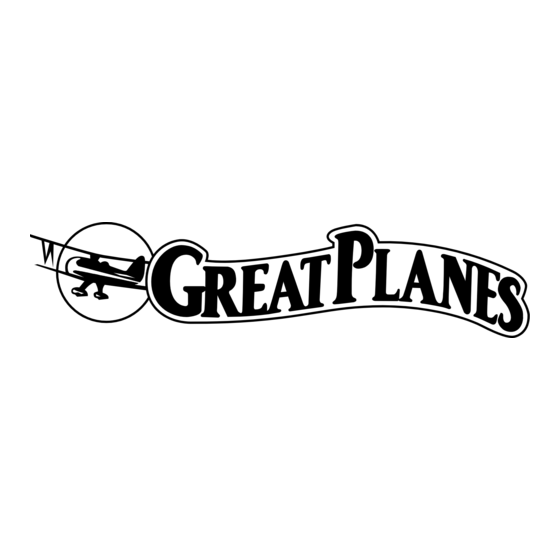GREAT PLANES EXTRA 330SC Manual de instrucciones - Página 16
Navegue en línea o descargue pdf Manual de instrucciones para Juguete GREAT PLANES EXTRA 330SC. GREAT PLANES EXTRA 330SC 20 páginas. Model aircraft great planes extra 330sc

Set the Control Throws
To ensure a successful fi rst fl ight, set up your Extra 330SC
according to the control throws specifi ed in this manual.
The throws have been determined through actual fl ight
testing and accurate record-keeping, allowing the model
to perform in the manner in which it was intended. If, after
you have become accustomed to the way the Extra 330SC
fl ies, you would like to change the throws to suit your
taste, that is fi ne. However, too much control throw could
make the model too responsive and diffi cult to control, so
remember, "more is not always better."
❏
1. Use a box or something similar to prop up the bottom
of the fuselage so the horizontal stabilizer and wing will
be level.
❏
2. Measure the 3D elevator throw fi rst. Hold a ruler vertically
on your workbench against the widest part (front to back) of
the trailing edge of the elevator. Note the measurement on
the ruler.
❏
3. Move the elevator up with your transmitter and move
the ruler forward so it will remain contacting the trailing
edge. The distance the elevator moves up from center is
the "up" elevator throw. Measure the down elevator throw
the same way.
❏
4. Measure and set the high and low rate elevator
throws and the high, low, and 3D rate throws for the rest of
the control surfaces the same way.
If your radio does not have dual rates, we recommend
setting the throws at the high rate settings.
NOTE: The throws are measured at the widest part of the
elevators, rudder and ailerons.
These are the recommended control surface throws:
LOW RATE
Up & Down
1"
ELEVATOR
[25mm]
18 deg
Right & Left
1-5/8"
RUDDER
[41mm]
19 deg
Up & Down
1"
AILERONS
[25mm]
13 deg
PREFLIGHT
Identify Your Model
No matter if you fl y at an AMA sanctioned R/C club site or
if you fl y somewhere on your own, you should always have
your name, address, telephone number and AMA number
on or inside your model. It is required at all AMA R/C club
fl ying sites and AMA sanctioned fl ying events (except when
fl own indoors). Fill out the identifi cation tag on page 18 and
place it on or inside your model.
Charge the Batteries
Follow the battery charging instructions that came with your
radio control system to charge the batteries. You should
always charge your transmitter batteries the night before
you go fl ying, and at other times as recommended by the
radio manufacturer.
CAUTION: Unless the instructions that came with your
radio system state differently, the initial charge on new
transmitter batteries should be done for 15 hours using
the slow-charger that came with the radio system.
This will "condition" the batteries so that the next charge
may be done using the fast-charger of your choice. If the
initial charge is done with a fast-charger the batteries may
not reach their full capacity and you may be fl ying with
batteries that are only partially charged.
16
HIGH RATE
3D RATE
Up & Down
Up & Down
1-7/16"
2"
[35mm]
[50mm]
25 deg
38 deg
Right & Left
Right & Left
2-5/8"
3-3/4"
[67mm]
[95mm]
32 deg
49 deg
Up & Down
Up & Down
1-3/4"
3-3/4"
[44mm]
[95mm]
22 deg
56 deg
